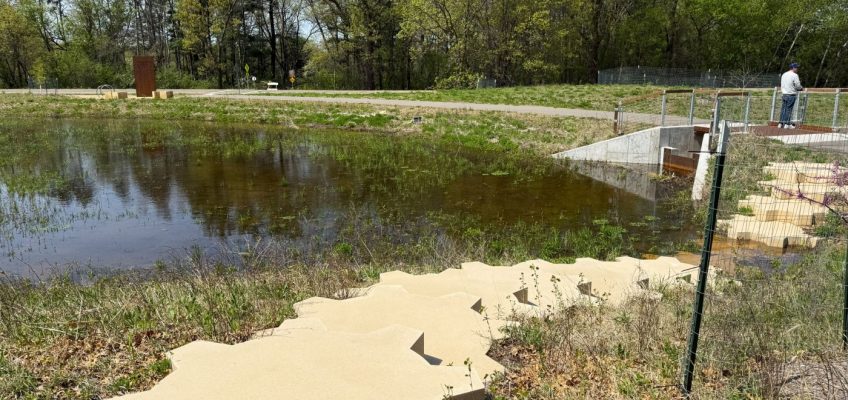Despite its importance to water quality, the infrastructure that filters and treats stormwater before it runs off into lakes is often invisible. These systems are usually moved into underground pipes or tucked alongside neighborhood ponds.
But a new Woodbury park is doing things differently.
At Hasenbank Park, which officially opened June 12, the South Washington Watershed District and city of Woodbury collaborated on public art and a unique design, aimed at bringing stormwater treatment into the open and encouraging neighbors to feel engaged in water-quality efforts, said Kyle Axtell, a project manager with the watershed district. An interactive online tool helps visualize how stormwater moves through the park.
“Flowing Roots,” a sculpture by Aaron Dysart at the new Hasenbank Park in Woodbury, resembles large plant roots made of plumbing fixtures, topped with a purple coneflower. The work highlights the overlap between nature and industrial design and is meant to encourage park-goers to think more deeply about water flow. (Courtesy of the South Washington Watershed District)
In addition to a connected series of water basins that filter runoff, the park also contains several large-scale sculptures: “Gears,” by Christopher Harrison, is a pathway of gear-shaped stepping stones over the water, and “Flowing Roots” and “Branching Out,” by Aaron Dysart, are a massive root structure and tree form, respectively, built larger-than-life with plumbing pipes.
“We’ve got stormwater management that people can see — it’s not just underground or hidden, and we wanted this to be a property and park space that the public would engage with,” Axtell said. “And what better way to help tell that story than through the use of art?”
Around 2018, the watershed district became concerned that water runoff from the Dancing Waters development, which drains into the Fish Lake wetlands off Valley Creek Road, would threaten the very high water quality in nearby Powers Lake.
Aaron Dysart’s sculpture “Branching Out” stands behind flowing water at the new Hasenbank Park in Woodbury on June 12, 2025. The sculpture, along with several other public art installations and design features, is meant to highlight the park’s active role in filtering stormwater to avoid polluted runoff into Powers Lake. (Courtesy of the South Washington Watershed District)
Separately, the watershed district was spearheading the restoration of Hasenbank Woods, a city-owned property that had become overgrown with invasive species and ash trees suffering from emerald ash borer infestations. The woods happen to be between the wetlands and Powers Lake, water officials realized, and the property also contained a small field the city had no plans for — so maybe two goals could be accomplished at once.
“It really came together as a win-win across the board,” Axtell said. “And in order to have healthy water, which is of course our primary mission at the watershed district, you’ve got to have healthy land.”
And the public art installations are more than decorative, he said — they’re a vital part of the park’s mission to pique people’s interest and encourage them to think about and learn about water-quality protection.
“It’s a way to engage the public that’s not just interpretive language on a panel,” he said. “We’re interested in showing people, more than telling people. Getting people to think about what we’re doing out here and why, as opposed to, oh, just read this paragraph and move on.”
South Washington Watershed District project manager Kyle Axtell, left, and artist Aaron Dysart, second left, talk with attendees during the rainy grand opening for the new Hasenbank Park in Woodbury on June 12, 2025. (Courtesy of the South Washington Watershed District)
This is how artist Dysart sees it, too. He’s well-known within the Twin Cities public art scene and was formerly St. Paul’s city artist, and has been working for several years on developing his two sculptures in Hasenbank Park. (He also created the F. Scott Fitzgerald sculpture in Cathedral Hill that was stolen earlier this year.)
“We’ve realized that you can have all the facts and data and pie charts in the world, but if you don’t have culture and connection, you’re not going to reach people,” he said. “To me, artwork and art as a visual language communicates in a different way — maybe not as direct, but more passionate, or bringing interest in learning a little more about what’s underneath your feet.”
Much of Dysart’s work looks at the intersection between natural wilderness and manufactured objects, he said, so the idea of a stormwater treatment park was particularly interesting to him. And his two pieces are meant to work together in highlighting the water cycle: Trees bring water from the ground into the air, he said, and roots move water from the air back into the ground. And using plumbing fixtures and pipes felt both apt and playful.
“I try my best to situate my work in the realm of throwing people off a little bit,” he said. “Not in a malicious way but in a joyful way, so that they can peel back the onion layers and start to dive in a little deeper.”
Related Articles
White Bear Lake native Joel Reichow is first to ever win half and full Grandma’s Marathon in career
What to know about this weekend’s Twin Cities Jazz Festival in Mears Park
BWCA entry permit fees could more than double under proposal
Skywatch: A telescope revolution is here
After surviving collapse, fire and Dillinger escape, Dakota County swing bridge begins new chapter


Leave a Reply